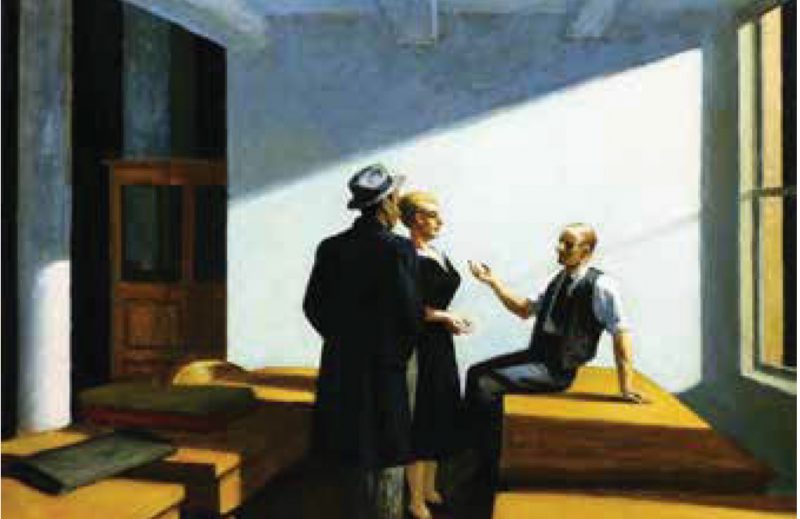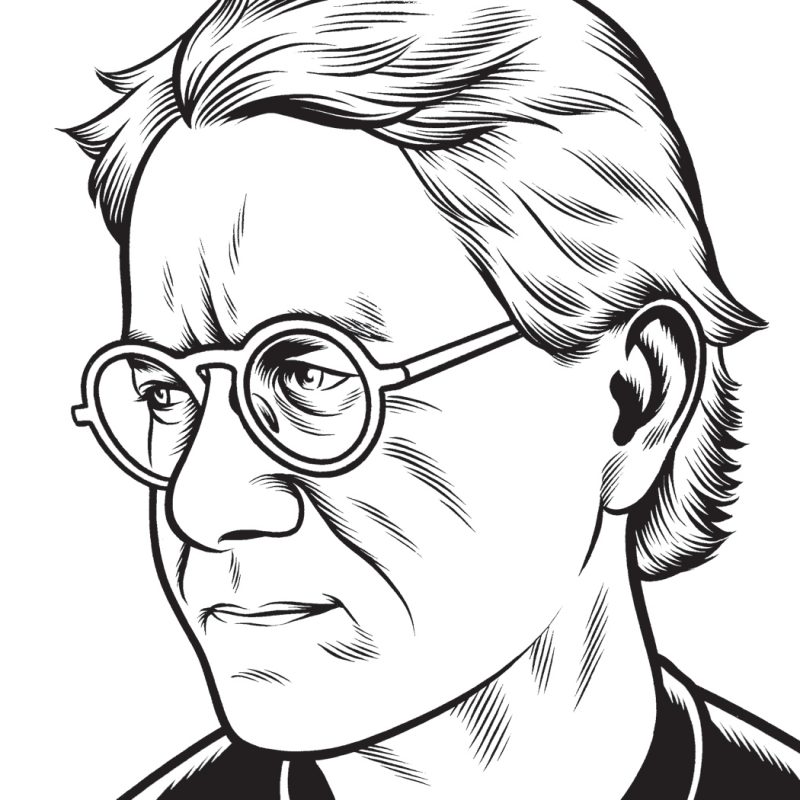(1) Kim Gordon with Nirvana, “Aneurysm,” Rock and Roll Hall of Fame induction ceremony, Barclays Center, Brooklyn (April 10). That Nirvana used its time onstage to have only women take Kurt Cobain’s place was the deepest kind of tribute to a man who in his music did everything he could to, in Camille Paglia’s words, “escape our lives in these fascist bodies.” But Joan Jett (“Smells Like Teen Spirit”), Lorde (“All Apologies”), and St. Vincent (“Lithium”) were karaoke. Late of Sonic Youth, Kim Gordon was the singer her song was asking for, whether it was Cobain or someone else, even if now the song was getting more than it asked for. In a gray dress—“a dress by Theory I found. It reminded me of the dress I wore on that 1991 tour with Nirvana, just about a foot longer”—she was fierce, her head down, her eyes hooded. As she charged across the stage, the song might have been trying to run away from her, scared to death, but it didn’t make it.
(2) Woods, With Light and With Love (Woodsist). Jeremy Earl’s Brooklyn band sounds less like Brooklyn—or anywhere, or any time—with each new record. The nine-minute title song is the sort of have-guitar-will-travel excursion you don’t hear anymore—John Andrews’s organ keening in the background, Earl’s high voice breaking the pace, then increasing the pressure until only another guitar can stand up to it. The Serpent Power did it with “The Endless Tunnel,” Neil Young with “Cowgirl in the Sand,” Steely Dan with “Do It Again” and “Reelin’ in the Years”—while this is playing, you won’t care. At the end, with “Feather Man,” Earl twists a single tiny theme on an acoustic guitar and suddenly you’re hundreds of years in the past, hiding out in the Scottish highlands, waiting for the invaders from the South. How did the band get from one place to another as if all they had done was move from one chair to another? With the sense that in the time it takes to move from one chair to another, the room might disappear.
(3) Bikini Kill, Yeah Yeah Yeah Yeah (Bikini Kill Records). For the seven 1991 live performances and practice sessions on the B-side: a band that can barely play discovering itself and realizing that getting better is the worst thing they can do.
(4) Bryan Ferry, the Fox Theater, Oakland, California (April 14). With a six-piece band, not counting his own keyboards and two backing singers whose outfits made them look like shimmying layer cakes, the music was mostly sludge, drowning in an echo broken only by the kind of paint-by-numbers big-move guitar solos that Ferry’s music doesn’t need and that Roxy Music was made to escape. The air cleared only for “Oh Yeah,” a lace curtain that’s been blowing in its window for thirty-four years without ever fraying, and John Lennon’s “Jealous Guy.” Roxy Music began playing it just after Lennon was shot; Ferry communicated all of the pathos he made the song shoulder then, and he made the song carry it now. You felt the way that death can swallow life, and how at least one song escaped.
(5) Secret Cities, Walk Me Home (Western Vinyl). Wonderful press-release lead for a group that, after Strange Hearts, recorded in 2011 over email, now steps out with an album made in an actual studio, albeit Tiny Telephone, in San Francisco, which I like to think is actually a telephone booth under the freeway, where the three got a sound somewhere between the two-girls-one-guy Fleetwoods, from Olympia, Washington, in 1959, and a barely existing female punk band like the Anemic Boyfriends, from Alaska in 1980: “Charlie Gokey delved into Roy Orbison’s ballads about losers in love while becoming a civil liberties attorney in Washington, DC. Alex Abnos locked into New Orleans soul masters like King Floyd & Dr. John as he became a journalist in New York City. And Marie Parker became a teacher in the band’s spiritual home of Fargo, North Dakota.” And Gokey has passed his new muse to Parker: in “Bad Trip,” “Playing with Fire,” and “The Cellar,” she recalls Paula Frazer of Tarnation, whose “Big O Motel”—“Heartbreak Hotel” but cheaper—remains the truest Orbison homage there is. She drifts through the songs, not as if she were walking down the street but as if the streets were walking by her, and she were watching.
(6/7) Kronos Quartet, “Last Kind Words Blues,” arranged by Jacob Garchik, in John Jeremiah Sullivan, “The Ballad of Geeshie and Elvie,” New York Times Magazine (April 13) and Nat Baldwin, In the Hollows (Western Vinyl). Sullivan tells a long tale of Geeshie Wiley and L. V. Thomas, two women from Houston who in 1930 recorded six inimitable sides for Paramount in Wisconsin and then disappeared. At the end of the online version—which also features videotaped interviews and all of the Wiley-Thomas recordings— the Kronos Quartet appears with a startling performance of Wiley’s most distinctive number. As Sunny Yang on cello, John Sherba on violin, and Hank Dutt on viola map the territory solely through pizzicato, making a setting where David Harrington’s violin follows Wiley’s original vocals like a second mind, as if Wiley would have sung the song without words if she could have gotten away with it, they rebuild the song from the first note up.
Best known for his playing with Dirty Projectors, Baldwin, leading on double bass and vocals, works with his own version of Kronos Quartet: Rob Moosre on violin, Nadia Sirota on viola, Clarice Jensen on cello, and Otto Hauser on drums. The attack is completely different. There’s peace of mind in the Kronos Quartet piece, as a goal; here the goal is harshness, bad weather, bad news. The music is precise, defined—nothing, you feel, could have been done any differently—and driven like a horse on fire. The pleasure this brings is bottomless: you’re in the presence of people who seem to know exactly what they’re doing without any faith that they’ll see another sunrise.
(8) Fairport Convention, “Tam Lin” (1969) in How I Live Now, directed by Kevin Macdonald (Magnolia Pictures). Howard Hampton writes in: “Best music cue of last year: the film drops a sullen, insulated American teen (Saoirse Ronan, impressively unsympathetic) into the country of Children of Men. She barely registers that the England she has been shunted off to is under siege; picked up at the airport by an underage cousin in a filthy jeep, she doesn’t want to make small talk, so he slips a cassette in the tape deck. What is this? she asks in dismay: Fairport Convention’s variant of the centuries-old ‘Tam Lin,’ where Richard Thompson’s electric guitar chords bring a dark sky to earth and Sandy Denny makes you believe she could turn men into trees. By the film’s end, the girl will have witnessed war and rape, shot two men, and dug through piled corpses to find the body of the boy in the jeep. You can never be sure what’s going on behind Ronan’s blankly piercing eyes, but you have the feeling ‘Tam Lin’ never leaves her head as the world is coming undone.”
(9) Conference at Night (2012), directed by Valérie Mréjen, in Hopper Drawing: A Painter’s Process, Walker Art Center, Minneapolis (March 13– June 20). The late ’40s in the United States were a kind of great exhaling: after holding its breath through sixteen years of depression and war, around 1948 the country finally began to breathe again. A new excitement, a sense of release, blasphemy, and possibility changed the way people walked and talked. It came out over the next years as “Howl,” On the Road, the music that would take the name “The Birth of the Cool,” A Streetcar Named Desire, Jackson Pollock’s Paleolithic splatter paintings, In a Lonely Place.
But there was also a great letdown, as the country returned to ordinary life, without the hero stories of the war or the horror stories of the Depression, and the letdown is what Hopper painted in 1949 in Conference at Night— or it’s what, more than six decades later, a French director and three French actors saw in the painting, and caught in a four-minute-and-fifty-four-second film.

After all the great adventures, three people talk dispiritedly, but insistently, as if they are trying to convince themselves that something actually depends on them doing something one way as opposed to another way, or doing it at all as opposed to not doing it at all, and about the maintenance strategies, memos, meetings, and accumulation of files, all to be dealt with tomorrow, that will be needed to keep the conversation going. It’s Office Space, generations away, in the flick of an eyelash.
(10) Bob Dylan in the ’80s: Volume One: A Tribute to ’80s Dylan (ATO). Aren’t tribute albums terrible? Sure. But they’re not usually a threat.
Thanks as always to Barbara Shelley and Andrew Keir.





